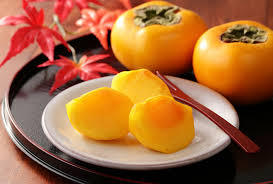
Persimmon fruit is a golden yellow, round or oval, flavorful, smooth textured delicacy of the Far East-Asian origin. Its sweet, delicious flesh is packed with much health promoting nutrients such as vitamins, minerals, and antioxidants vital for optimum health.
Persimmon trees classified broadly into two general categories: those that bear “astringent fruit” (while unripe) and those that bear “non-astringent” fruits. An astringent cultivar, which is commonly cultivated in Japan known as “Hachiya,” is high in tannins and must be allowed to ripen completely on the tree itself until it attains jelly-soft consistency before accepted to be fit for consumption. A non-astringent persimmon, on the other hand, contains less tannin and can be eaten while it is crispy, as in apples. Astringency can be removed by treating the fruit with carbon dioxide or alcohol.
Benefits of persimmon fruit
- Persimmon fruit is moderately high in calories (provides 70 calories/100 g) but very low in fats. Its smooth textured flesh is a very good source of dietary fiber. 100 g of fresh fruit holds 3.6 g or 9.5% of recommended daily intake of soluble and insoluble fiber.
- Persimmons contain health benefiting flavonoid polyphenolic antioxidants such as catechins and gallocatechin in addition to having an important anti-tumor compound, betulinic acid. Catechins found to have anti-infective, anti-inflammatory and anti-hemorrhagic (prevents bleeding from small blood vessels) properties.
- Some of other antioxidant compounds found abundantly in this fruit are vitamin-A, β-carotene, lycopene, lutein, zeaxanthin and cryptoxanthin. Together, these compounds work as protective scavengers against oxygen-derived free radicals and reactive oxygen species (ROS) that play a role in aging and various disease processes.
- Persimmons are also a very good source of vitamin-C. Regular consumption of foods rich in vitamin-C helps the body develop resistance against infectious agents and scavenge harmful, pro-inflammatory free radicals.
- It is good in many valuable B-complex vitamins such as folic acid, pyridoxine (vitamin B-6), thiamin, etc. These vitamins act as co-factors for numerous metabolic enzymatic functions in the body.
- Fresh and dry Persimmon fruits also contain healthy amounts of minerals like potassium, manganese, copper, and phosphorus. Manganese is a co-factor for the enzyme, superoxide dismutase, which is a very powerful free radical scavenger. Copper is a co-factor for many vital enzymes, including cytochrome c-oxidase and superoxide dismutase (other minerals function as cofactors for this enzyme are manganese and zinc). Copper also required for the production of red blood cells.
Selection and storage
Astringent variety persimmon fruits generally harvested while they are hard but fully matured. On the other hand, Non-astringent types can be ready for harvesting when they achieved full-color and slightly soft in consistency.
Astringent persimmons usually continue to ripen at room temperature. Both kinds of persimmons should be gathered from the tree using hand-held pruning shears (as in mango), leaving the calyx intact, unless the fruit is to be used for drying while taking care not to bruise.
In the stores, select fresh fruits featuring bright yellow-orange color without any surface bruises or cuts on them. “Dried persimmons” can also be available readily in the supermarkets and feature many similarities to dried apricots.
Mature, hard, astringent persimmons can be stored in the refrigerator for several months. Non-astringent varieties have short shelf span and can be stored for only a few days at room temperature.
【Reference】https://www.nutrition-and-you.com/persimmon-fruit.html






